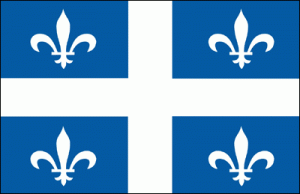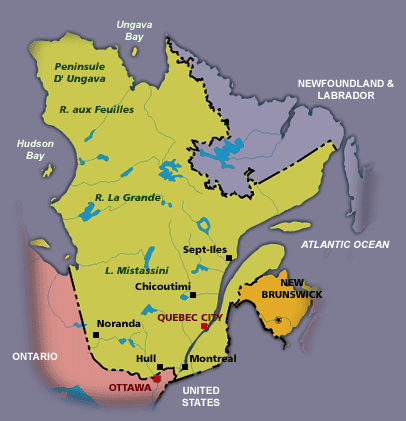Québec
Pray:
- Pray for the Aglow groups and leaders to be strengthened.
- Pray for all the resources and creativity needed to fulfill the intentions of God in the province of Québec.
- Pray for the Aglow prayer group in the Capital city.
- Pray for godly government leaders. Blessed is the nation whose God is The Lord, the people whom He has chosen for His own inheritance. Psalm 33:12
Proclaim:
- Arise, shine; for your light has come! And the glory of the LORD is risen upon you. For behold, the darkness shall cover the earth, and deep darkness the people; but the LORD will arise over you, and His glory will be seen upon you. Isaiah 60:1,2 (NKJV)
- Lift up your heads, O you gates! Lift up, you everlasting doors! And the King of glory shall come in. Who is this King of glory? The Lord of hosts, He is he King of glory. Psalm 24:9-10 (NKJV)
Interesting Facts About Québec
Population: 8,155,334
 Government: As a Canadian province Québec is one of 10 partners of the Canadian federal State, whose parliamentary system is modeled on the British system. Each province has its own legislature and adopts legislation in those fields that fall under its jurisdiction. The Canadian Parliament has jurisdiction over the entire country in fields such as external affairs, national defense and currency.
Government: As a Canadian province Québec is one of 10 partners of the Canadian federal State, whose parliamentary system is modeled on the British system. Each province has its own legislature and adopts legislation in those fields that fall under its jurisdiction. The Canadian Parliament has jurisdiction over the entire country in fields such as external affairs, national defense and currency.
In Québec, the provincial parliament is known as the National Assembly. It enacts legislation and the lieutenant-governor, who represents the Crown, gives assent to such legislation. The prime minister (premier), the leader of the majority party, is the actual head of the provincial government and presides over the executive council. The National Assembly is made up of 125 MNAs elected by universal franchise. Members of the legislature are popularly elected to a 5-year term; however, the lieutenant governor, on the advice of the prime minister, may call for an election before the term has been completed.
The prime minister may be elected as many times as he wishes to stand as a candidate. MNAs are elected under the majority system (50% plus one vote): the voter selects only one of the candidates running in his riding. The winner is the candidate who receives the most votes in this single ballot. Québec is represented by 24 senators appointed by the Canadian governor-general in council and by 75 members in the House of Commons popularly elected to serve terms of up to five years in the Canadian Parliament.
People: Nearly 80% of Québecois live near the shores of the Saint Lawrence River. Almost 80 percent of Québecois live in urban centres located along the St. Lawrence. Montreal and its suburbs have a population of over three million. Of a total population of about seven million, Québec has more than five million people of French origin, 350 000 of British origin and about 137 000 Amerindians (Mohawk, Cree, Montagnais, Algonquin, Attikamek, Mi’Kmaq, Huron, Abenaki and Naskapi), Métis and Inuit. French is the mother tongue of 83 percent of Québecois, while approximately 10 percent cite English as their mother tongue.
Québec’s population density is low, i.e. 4.7 inhabitants per square kilometre. This figure is scarcely significant given the immensity of the territory and the very sparse population in northern Québec (only 35,000 inhabitants). Italians and Eastern Europeans were traditionally the largest immigrant groups to Québec, but since 1960 Portuguese, Haitians, Lebanese, South Americans and Southeast Asians have swelled the ranks of new Québecois. Since the end of World War II, more than 650,000 immigrants from over 80 countries have moved to Québec, particularly to the city of Montreal.
History: Amerindians of the Algonquin and Iroquois nations and language groups lived in the woodlands and river valleys of Québec. The northern part of the province was, and still is, inhabited by Inuit. The watershed of the mighty ‘Canada River’ (the Saint Lawrence) had been a rich homeland to agricultural and foraging peoples who lived in fortified towns along its banks for thousands of years prior to the arrival of the French ‘explorer’ Jacques Cartier in 1534
The early French era was characterized by a thriving fur trade, a struggle for survival and relatively friendly relations with the Aboriginal people north of the St. Lawrence. It was also characterized by an ongoing rivalry between the French and the Iroquoian people to the south. At this time France was also involved in worldwide rivalry with Britain and the other colonial powers.
Founded in 1608, Québec City became the capital of New France. During the French regime, the fortified city was an important centre of trade and development. Today it is regarded as the cradle of French civilization in America and was named a World Heritage City by UNESCO in 1985.
In the early 17th century land along the St Lawrence River was divided into concessions called seigniories, granted to noblemen. The noblemen then conceded part of their land, which they divided into lots and sold to the colonists. The seigniories were divided into long narrow lots fronted by the river or its tributaries. As the river was then the only navigable route, it was also the main means of transportation.
French-British rivalry in North America culminated with the Seven Years’ War, which saw the fall of Québec City to British forces in 1759. With the Treaty of Paris in 1763, New France became a colony of Britain. In 1774, under the Québec Act, Britain granted official recognition to French Civil Law, guaranteed religious freedom and authorized the use of the French language. With the Constitutional Act of 1791, the colony was divided in two to reflect the large influx of United Empire Loyalists who fled north after the American Revolution to settle in western Québec.
This led to the creation of Upper Canada (now Ontario) and Lower Canada (Québec) and the division of much of the old signeurial land into square ‘townships.’ After rebellions in both Upper and Lower Canada in 1837, the two were reunited by the Act of Union, 1840, and became the Province of Canada. In 1867, with the passage of the British North America Act, Québec became a founding member of the new Dominion of Canada.
Historically, Québec with its rural and Roman Catholic religious roots was a traditional, agrarian society. The advent of electrification and the second industrial revolution between 1920 and 1940, brought urbanization, higher living standards and an easing of the ‘sway of the Church.’ In the 1960’s Québec entered yet another period of transition: the “Quiet Revolution.” It was a period marked by rapid economic expansion, social disruption, cultural pride and a re-emergence of French Canadian nationalism. In 1980 a provincial referendum was conducted on negotiating an arrangement for sovereignty association with Canada. The referendum was narrowly defeated by a majority of Québec citizens, as was a second referendum held in 1995.
The Parliament of Canada passed a resolution recognizing Québec as a distinct society in1995.
Throughout Québec’s history, the survival of the “French fact” in Québec has been central to the concerns of Québecois. It is this very aspect that reflects Québec’s distinct place in the Canadian Confederation and gives Canada much of its bilingual character and cultural richness.
Interesting Facts information from the library.educationworld.net/canadafacts website. Read more about Québec


Canada et plus precisement Quebec est a Christ . groupe aglow du Quebec: ma soeur Kabore et moi : Bayala faisons parti de ce groupe Aglow. Pour les sujets de priere contactez nous . j’ai reçu en voyant la carte De cette province que la main du Seigneur soutient Le Quebec. Dieu est un Dieu de plan et d’objectivite. Nous sommes exhausses au nom de Jesus. Amen. Pierrette Bayala .
I would like to travel to Haiti to assist where needed in the area of finances and the economy.